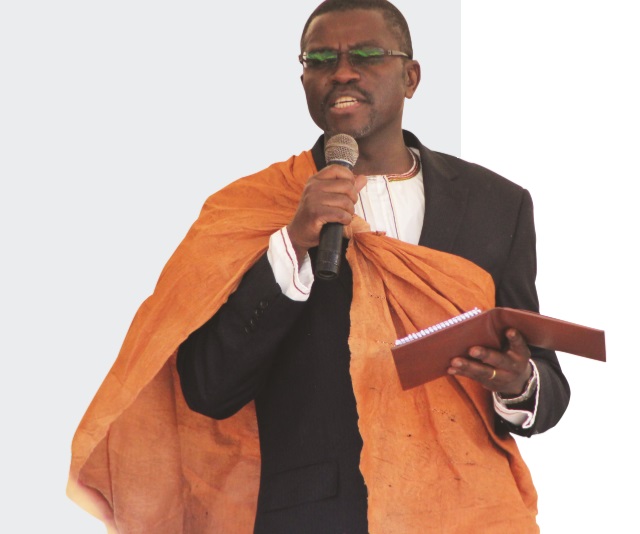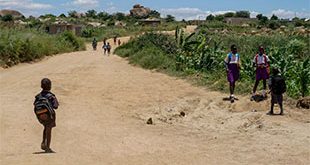
The Kamuswaga land issue comes at a time when the Buganda monarch is under pressure over a land leasing scheme it recently introduced dubbed Kyapa Mu Ngalo (Land Title in your palm).
Under scheme, tenants on Buganda kingdom land are required to purchase 49 years leases. About 130,000 estates of various sizes are affected. Apparently, the project has cast in bad light Mayiga who unveiled it on April 18 and the Buganda Land Board which is implementing it.
But the onslaught on the Kabaka first erupted in September 2016 when a relatively unknown young lawyer, Hassan Male Mabirizi, went to court asking it to declare that the Kabaka is not the landlord of Buganda but only a trustee and should not, therefore, individually benefit financially from its wealth; especially land.
Then the Kabaka was sued by descendants of his grandfather; the late Kabaka Daudi Chwa who was the reigning monarch when in 1900 when an agreement between the British colonial administration and kingdom officials led to a parceling out of huge chunks of kingdom land amongst the monarch, its chiefs and officials, and the British crown.
The Kabaka’s siblings have also petitioned court to instruct the Uganda National Roads Authority (UNRA) not to hand over to the Buganda Land Board (BLB) Shs300 million for compensation of land in Masajja, Wakiso District where the proposed Kampala Jinja Express Highway is to pass. In the long-running dispute, the royals assert that land is part of the estate of their late grandfather, in which they are equal heirs with the Kabaka. The royals say that on October 23, 2015, the family court ordered the Attorney General to deposit the money of the Masajja land on the account of High Court until their lawsuit is disposed of but they were surprised to see on June 16, 2017 a letter written by the Deputy Attorney General instructing UNRA to pay the monies to BLB. The royals also on May 24 petitioned the ongoing commission of inquiry into land matters by Justice Catherine Bamugemereire’s to investigate BLB’s control over the estate of Kabaka Chwa.
A subject suing the Kabaka took many by surprise whereas the law suit by the royals brought back memories of 1989 when three Buganda princesses disowned Kabaka Mutebi saying he was not their father’s son. Unlike today when they have sued the Kabaka, in 1989 the princesses simply held a press conference in the Masiro (Royal Tombs) at Kasubi and were taken seriously.
Critics of the 1900 Agreement say that with a stroke of a pen, it rendered landless all ordinary Baganda peasants who had previously lived unchallenged on their ancestral estates. This is the origin of the Mailo land tenure system, which is unique to Buganda, and has contributed to sometimes convoluted claims by landlords, bonafide tenants, and squatters. Until now, the retort Mengo has been the monarch merely holds the Buganda land in trust. But the reality is that Mailo land has been heavily traded and the previously huge chunks chopped up at each sale. The Kyapa scheme is being seen as a ploy by the monarch to consolidate its grip on the land. But Katikkiro defends it as meant to protect bibanja holders (bona fide tenants) from evictions. While addressing the Buganda Lukiiko (Parliament) in May, Mayiga said it is wrong for people from “Patagonia” to criticise it. For some, the word Patagonia was deemed offensive and Buganda elder Abdu Nadduli who is a Minister without portfolio and former Presidential Advisor on Buganda issues took a swipe at Mayiga over it.
“How can he refer to those who oppose Ekyapa mu Ngalo as Patagonians? I have been told these are people with big feet who live in South America. We fought for this country, we cannot be referred to as Patagonians,” Nadduli said.
 The Independent Uganda: You get the Truth we Pay the Price
The Independent Uganda: You get the Truth we Pay the Price




“Buganda Kingdom Prime Minister, Katikkiro Charles Peter Mayiga could be punished with a sacking over court cases over land involving his boss, the Kabaka Ronald Muwenda Mutebi 11.” I do not know whether “The Independent” is facing “desperate times”, but there is “unity to desperate events” in this story. There is an “imaginary connexion” between the position of the Katikkiro and that of the emerging court cases that cannot be substantiated with facts. I would like to dispel any false hope from that of this writer to any of the anxious reader, that the Kabaka of Buganda can’t and will not “punish” or “sack” the Katikkiro of Buganda over court cases that are not of his natural or professional cause. These are machinations and in furtherance of the hate campaign against the Great Kingdom of Buganda by ignoramuses. The idea is that, any deterrence in the progression of the Kingdom will somehow ignite their rather whittling political hopes. I will, for instances of clarity, take a long look at history for a rather logical conclusion from the reader. I will look at the circum-stances of the pre-colonial Buganda to the independence. In particular, the 1900 Buganda Agree-ment and the 1961 Buganda Agreement in accordance to the draft of the 1962 Independence Con-stitution, the 1995 Constitution and the “Ramifications of ‘E’ kyapa mu ngalo.”
At the advent of colonialism, Buganda had a feudalistic arrangement on land. The Kingdom was arranged through a clustered clan system- at the lowest level was the family (Amaka). Since Buganda is a patriarchal society, the family was headed by a man (father). From the ‘Amaka’ next came in the ‘Olunyiriri’ ( these could be two or more closely related families), in next came ‘Omutuba’ (a larger union of close families), then, ‘Esiga’ (a large union of loosely related families) and then came in ‘Omutakka’ (Clan Head) and lastly, the ‘Ssaabatakka’ (the Kabaka). At a close look of this hierarchical ladder, there is a “relative linkage” between every Muganda and the Kabaka. The Buganda clan- family system creates a strong social bondage between every Muganda and the Kabaka. But for purposes of this comment, I will restrict this discussion to issues regarding land. By his very title “Ssaabatakka”, all land belonged to the Kabaka but to an extent this was only in title (by name). It is true that the Kabaka owned huge chunks of land and he could allocate it according to his wishes but it is also true that every family in Buganda owned a home (Amaka). A man in Buganda held his family on a piece of land (ttaka) whereupon they could cultivate, parcel it out to his grown up children and pass on “ownership” upon his death. This system of “Amaka” is what led to the Buganda social system that starts with “Amaka” and ends with a “Ssaabatakka” (Kabaka) – it is a “bottom – up” social order. How did Buganda relate to the outside world? Buganda had an aggressive expansionist policy mostly at the detriment of its neighbours. The lands and peoples that were annexed, were normally “co-opted” into the social standing order of the clan system. This fact of life makes Buganda not just a single tribe but rather a nation.
Buganda was declared a “British Protectorate” in 1893. It is only ironical that the “protectors” de-posed Kabaka Mwanga only four years later in 1897. In 1900 the colonialists made their intentions very clear under the 1900 Buganda Agreement. They entered into an “agreement” with an infant “King” of three years. The opponents of Buganda’s aspiration pounce on this infamous event like the proverbial vultures. They so much accuse of the Kingdom for having entered an unfair “agreement” and conspicuously “absolve” the mastermind. Incredible. In 1904 the colonialists introduced the cash economy by introducing two cash crops, that is- Cotton and coffee. The emergency of a cash economy brought in a capitalistic element of “individualism.” The “strong” landlords would coerce people to work in their gardens for profit maximisation. Similarly, the “lazy” landlords could give away their lands at a fee for others to till but not to own. These two compelling forces of a strong landlord wanting “more” and a lazy landlord getting “something”, led to what we now know as ‘Kibanja’ (singularity) or ‘Bibanja’ (plurality). For easy reference, let me dwell upon what transpired in the 1900 Agreement. Sir Harry Johnston, represented Her Majesty’s government as Special Commissioner in Uganda and the Kabaka was represented by regents (Stanislus Mugwanya, Zakaria Kisingiri and Apollo Kaggwa, and Chiefs of Buganda. By the stroke of a pen Her Majesty’s Government (Protectorate) acquired one-half of all the land in Buganda (10,550 sq. Miles and came to be known as ‘Crown land’). The other category was ‘Mailo’ it had two sub divisions. It stated of an “Official Mailo.” These were grants of land attached to specific offices in the Buganda Local Government. They could neither be sub-divided or sold and instead passed intact from the original land holder to his successor. This includes the famous 350sq miles of the Kabaka. This is land that was given to Daudi Chwa who passed it to Edward Mutesa who passed it on to Ronald Mutebi and who will pass it on to his official successor. The other sub category was “Private Mailo.” In these estates, some 1000 chiefs and private land owners were allocated 8,000 square miles of land. The Private Mailo land owner held rights in his land akin to those of a free hold. He was free to sell all or part of his holding and to pass it to his successors either under customary inheritance procedures or through a will. It should be noted that this agreement was originally called ‘The 1900 Uganda Agreement’ but it was later renamed ‘The 1900 Buganda Agreement’ simply because all matters pertaining therein, concerned a particular region called Buganda. The “Agreement” did not only delimit the powers of the Kabaka but it fundamentally delineated the social relations of the people of Buganda. Kabaka’s word on land was no longer final. He was now being restricted to 350sq miles of which he only held in trust. The Omutaka (clan head) could sell or give away his clans mates’ land at his own pleasure. The socio-political and economic functioning and outlook of Buganda had completely changed. The customary ownership of land in Buganda had been greatly eroded. It was now everyman for himself. At this point, let us remember four things: 1) Buganda had lost one-half of its land to the Protectorate government (under crown land). 2) The Kabaka was now limited to 350sq miles and if he needed more, it meant that he had to buy it. 3) That the livelihood of the Baganda now depended on the mercy of the “client-chiefs.” and 4) With the introduction of the cash economy the customary land tenure system was interrupted and by implication brought about two classes of people- the landlords and the landless. To argue, as to what might have brought us thus far, may not be a matter of fact but one of analysis.
With the acrimonious environment of the Bibanja (leasehold), the colonial government came up with the Envujjo & Busuulu law (1928). It was enacted as a result of complaints from tenants over the land lord’s increase in the rate of busuulu and envujjo (rent) payable. Under this law, the rates were standardised and restricted and the peasants could not be forced off their bibanja without an order of Court. Fast forward. In October, 1961, one year before the attainment of the Uganda independence, there was an agreement between Her Majesty’s Government and the Buganda Government. It decided to recommend among other things that the new constitution should be established for Uganda under which Uganda would enjoy internal self- government and “Buganda would be united with the rest of Uganda in a federal relationship.” It is noteworthy that Buganda had refused to join the Lancaster Conference unless it was granted a federal status. This was being helped by the fact that Her Majesty’s Government was to grant Uganda “Independence” only if all the concerned parties were on the table. This is how the UPC and Dr. Milton Obote became the first government and Executive Prime Minister respectively. The 1961 Agreement went further and spelled out the relationship between Crown land in Buganda and Public land of the Kabaka’s Government. In Clause 19 – (1) said in part: “The freehold of Crown land in Buganda occupied by the Uganda Government for its own purposes shall be vested in a Commission for public land (hereinafter called “the Uganda Land Commission”), which shall hold land on behalf of the Uganda government for the benefit of all people of Uganda (including the people of Buganda). Clause 19 – (3), stated: “There shall be a land Board for Buganda (hereinafter referred to as “Buganda Land Board”), in which shall be vested all public land of the Kabaka’s Government; the Board shall hold such land in the name of the Kabaka on behalf of and for the benefit of the people of Buganda.” This among other provisions of the Agreement are the factors that assured Buganda’s participation at the Lancaster Conference. It is absurd that Buganda was “cheated out” of the Uganda Independence arrangement. Four years into “self governance”, then Prime Minister, Obote ousted the President. He later abolished Buganda Kingdom alongside other Kingdoms through the Pigeon-hole constitution that was later to become the “Republic Constitution (1967). In 1993, under the “THE TRADITIONAL RULERS- RESTITUTION OF ASSETS AND PROPERTIES ACT (Chapter 247), the NRM Government promised to return all assets that had been confiscated by previous governments. In many aspects, this was another “Buganda Agreement” with a more less “Protectorate government.” It is widely believed that by this gesture of “returning Buganda’s assets”, the NRM government was simply fulfilling its “bush promise” of the “federo” type of governance. If this were the case, then the NRM government couldn’t be further from the truth. Under the “federo” arrangement, Buganda is not only clamouring for “land titles”, it is agitating for a semi- autonomous rule under the Kabaka with a defined territorial sphere, judicial, legislative and Budgetary powers. A similar arrangement as arrived at the Lancaster Conference.
Under the 1995 Constitution, (Article 234), spells out four types of land ownership in Uganda. Clause 2(b) is about Mailo land and it states: “Mailo;This was created by the 1900 Buganda Agreement. It is owning of land formerly given to the Buganda chiefs in and outside Buganda. It is similar to freehold tenure except that tenants on mailo land have security of tenure.” It talks of tenants on Mailo land should possess security of tenure. Implying that there should be an instrument expressing the same. Clause 2(d) is about Leasehold and it states: Leasehold; “This Is owning of an interest in land based on an agreement with the owner of the land al-lowing another person to take possession and use the land to the exclusion of any one else for a specified or limited period of time, usually five years, forty nine years or ninety nine years, on payment of money or giving service. When one dies, the successor takes over the lease.” The 1995 Constitution, under Article (246) recognises the Kabaka as an institution. Specifically Clause 3(a) states: “the institution of traditional or cultural leader shall have capacity to sue or be suedand to hold property on behalf of itself and the people concerned;” The explanation is: the Ugandan constitution recognises the Kabaka as the “custodian” of the 350sq miles. It goes on and give him execution powers and ways to execute. Ekyapa mu ngalo just fulfils this “Constitutional path.” There are tenants on Kabaka’s official Mailo land. How else would Mengo (Buganda’s seat) “ensure” their tenancy? The animosity that the Central Government expressed towards the exercise of ‘E’kyapa mu ngalo’ is either out of lack of proper information or sheer bad blood towards Mengo. But we’re a people with a common heritage and a common purpose. We shall not be derailed by opportunists, not by hate, not by intrigue or greed. We shall try to seek for love and respect from mutual friends. We shall remain true to our cultural values and heritage. We shall not weaver even when in a hole of the storm. We shall build bridges where there gaps. We shall make pathways when faced with brick walls. We shall say “yes” to the “naysayers.” We shall remain true to the “Buganda cause” and the fight starts with me. Onee can only be grateful to Katikkiro Charles Peter Mayiga for giving us that belief and it can’t begin with a “sacking.”
Wow! I ain’t a muganda but I feel the deep sense of belonging from Mr Rajab. I am certainly not competent to discuss buganda but I admire your zeal of defending what you strongly believe in. I wish we all fought for Uganda as a whole the same way.
If we all believe that Buganda is part of Uganda then my sense of belonging can’t be any different from yours. Injustice anywhere is injustice everywhere.